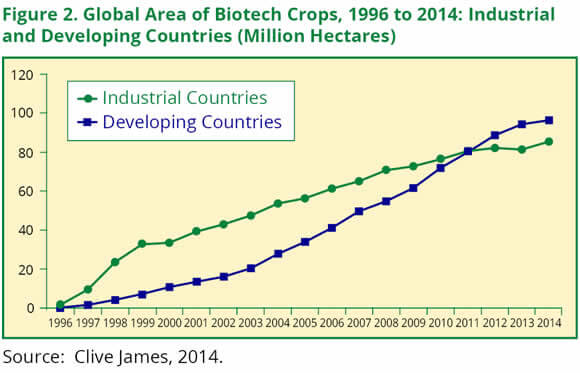One of the most contentious and polarizing issues today is the use of biotechnology in farming. While many farmers in industrialized countries have been safely and successfully using genetically engineered crops for almost two decades, adoption in the developing world has been significantly slower, only recently eclipsing the U.S. in terms of total acreage.

Many of these crops have been developed to produce naturally occurring nutritional compounds, resist aggressive diseases and tolerate extreme environmental conditions. The benefits of GE crops are not equitably spread throughout the developing world, as those in most critical need often cannot benefit from existing solutions created by public scientists.
The slow global adoption of the technology is tied mostly to political resistance stirred by unsubstantiated fears that generate anti-GM sentiment amongst the broader public. In the developed world, some companies — Chipotle most recently — have been willfully leveraging this phenomenon to deceive consumers. The burrito fast food giant “banned” GMO’s from its menu to create an image that its 900+ calorie burritos are somehow better for you. Yet, Chipotle continued to use meat that was raised on GM grain, cheese made with a GM enzyme, and sodas containing high fructose corn syrup derived from GM corn. These changes were all obviously a marketing gimmick and only one example of what’s happening today by food related companies.
Unsubstantiated fears about the safety of GM crops in developed countries with an over-abundance of food has spread anti-biotech sentiment to the poorest parts of the world, biasing both citizens and policy makers. In turn, politicians are pandering to the loudest voices amongst their constituents, resulting in them lobbying against a technology that could help those who need it most: the critically malnourished.
Recently, I attended a conference where I interacted with an array of people including scientists, farmers, bee keepers and journalists. All had their own unique perspectives on biotechnology. But my most memorable interactions were with with scientists from Africa who are working diligently to put crops in the hands of farmers that help feed and nurture their growing population. One of these scientists was Dr. Chiedozie Egesi, a Nigerian crop breeder.
Dr. Egesi’s breeding program focuses primarily on cassava, a staple crop in many equatorial nations, and uses both biotechnology and conventional breeding methods to generate new varieties that can help small-scale farmers produce wholesome food in key areas of need in Africa. But lack of biosafety legislation in Nigeria — anti-GMO activists have erected formidable political barriers to passage — has slowed his breeding program and made it difficult for farmers to introduce these crops into their rotations. Currently, Egesi’s genetically modified crops must be destroyed after each research project is completed—an unwarranted demise for crops that could potentially reduce non-communicable diseases (e.g. blindness) resulting from vitamin deficiencies.
At dinner during the conference, a discussion about the debate over genetically GM crops within the United States turned to the situation in Africa, when Erostus Nsubuga, a Ugandan conference delegate, said “People are dying of hunger in Uganda. We are willing to use any technology.”
It was a startling statement and wake up call, challenging our complacency. As Americans continue to quibble about phantom fears related to genetically modified crops, 20,000 people—more than six World Trade Center disasters—die every single day from malnutrition, at least some of whom would be saved if GM crops were legalized.
What’s frustrating is that public scientists with no connections to multinational seed or biotechnology companies have developed a wide array of nutritious, wholesome crops (golden banana, golden rice, biofortified cassava, etc.) that could drastically reduce these numbers if deployed to farmers, but their development is arrested by politics and activism. And while every person has the right to be skeptical, there isn’t a single documented case of a health issue in humans or animals related to a GM crop to date. In order to be regulated for public use, these crops must go through the most intensive battery of tests in the history of agriculture, yet people, responding to activist protests, remain afraid.
Scientists need to become better at communicating what GM technology is, how it’s different than what we’ve done in the past, how it’s better than what we’ve done in the past and how it can improve lives.
Even though mountains of evidence support the safety of GM crops—every major independent science organization and regulatory agent of note has publicly concluded they are as safer or safer (because of extensive testing) than other conventional or organic crops—a non-scientific, social and political debate still rages on in the world’s wealthiest nations, in places with limitless amounts of food. Is it not selfish and cruel to refuse a technology that could help those who have so little?
(If you read at an average speed of 300 words per minute, 40 people died from malnutrition as you read this article).
Thanks to Dr. Kevin Folta and Jon Entine for their critical review of this piece.
Michael Dzakovich is a graduate student studying photobiology and controlled environment agriculture at Purdue University. Follow him on Twitter @MDzakovich































